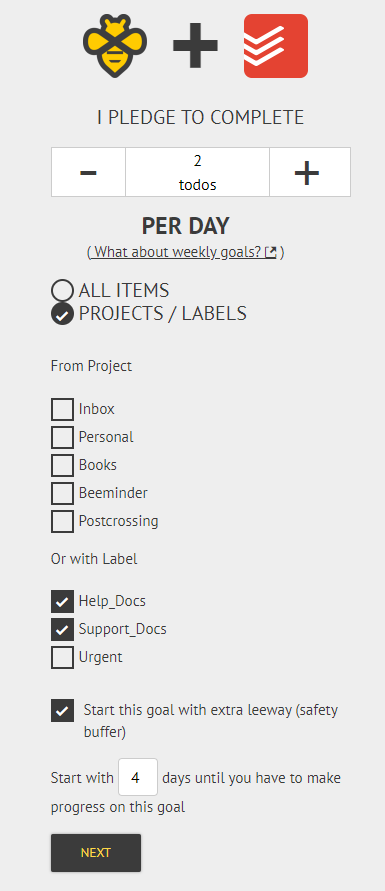Todoist
- What can I beemind with Todoist?
- If I choose to include tasks from a particular project and a particular label, what happens?
- I checked off my tasks, but they aren't counting toward my Beeminder goal
- Can I change which projects are included?
- A datapoint entered by Todoist changed to zero!
- Todoist sample goal setup
Todoist is a to-do list app which allows users to organize their work and life.
What can I beemind with Todoist?
Completed tasks! You can beemind all your completed tasks, or only completed tasks under specific labels or projects.
If I choose to include tasks from a particular project and a particular label, what happens?
If you pick both a project and a label, the graph will track items that are either connected with that particular project, or with that particular label. That means you can't use this to narrow it down to items in a particular project that also have a certain label. It's an OR not an AND, in other words.
If that's bothersome, we'd love to hear more about the use-case, but no promises!
I checked off my tasks, but they aren't counting toward my Beeminder goal.
First thing to do is double-check that you didn't set up the Beeminder goal to track only specific projects or labels, and check if the tasks you're checking off are under the correct projects/labels. If all of that looks right, try a manual fetch: does that help? If so, then most likely we just hadn't done a recent automatic fetch.
If tasks are still missing, get in touch with us! We'd love to dig in and get things figured out.
Can I change which projects are included?
Yep! Just go to your goal's settings on the web version, and scroll to the "Todoist settings" section. There you can add and remove projects and labels for us to start or stop tracking.
Word of warning: if you remove a project or label to tell us to stop tracking it, Todoist will tell us that those tasks no longer exist or were uncompleted (because they will no longer appear in the list of completed tasks they show us), and we'll zero out recent entries from those labels/projects. If that happens and you derail, just reply to the legitimacy check email as soon as you can to let us know, and we'll help fix things up and ensure you aren't charged.
A datapoint entered by Todoist changed to zero!
This can happen when you uncomplete a task, move or delete tasks, or change what projects the goal is tracking, because we stay in sync for at least 7 days to ensure that no data is lost and that we can update any changes (such as extra completions that didn't sync to Todoist's server in time for your deadline). If a task disappears from Todoist's log for the sections we're tracking, then we remove it too. If this causes a non-legit derailment, just get in touch and let us know.
Recurring tasks can be a particular problem, since deleting one of those turns a bunch of past datapoints to zero. An intrepid user discovered that the workaround for this is to use the "complete forever" option in Todoist, rather than delete the task.
Todoist sample goal setup
- Head to create a new goal (also accessible through the New Goal link in the top menu).
- Click the Todoist icon to start a new goal using Todoist data.

- If you haven't already authorized Beeminder to access your Todoist information, you'll need to do that first by clicking Connect to Todoist. After authorization, we'll return you to the next step.
- First, decide the rate at which you want to complete to-dos.
Next, you can opt to track only tasks from specific Projects or Labels. The default option tracks all your tasks. To filter the tasks Beeminder recognizes, select the Projects/Labels option and check each of the Projects and/or Labels you want to use. In this example, I'm setting up a goal for improving these help docs. Anything tagged with "Help_Docs" or "Support_Docs" will count for this goal.
Finally, if you want to delay your goal's start a few days (maybe you're traveling this weekend), be sure to tick the Start this goal with extra leeway box. Enter the number of days you want to delay and press Continue.

- Give your goal a name. If you want, you can also write a short description with more information.

- Finally, choose your initial pledge. This is the amount you will pay the first time you derail on the goal. After derailing, the pledge will increase by default — use the dropdown below to control how high it goes by selecting the cap. In the example below, I have chosen to start at a $5 pledge, which will increase each time I derail, until it reaches $270 — the pledge cap. (To read more about pledges and payments, check out some FAQs!)
If you want to start out with a sort of trial period, you can choose to start the goal at $0. If you do that, the pledge will automatically increase to $5 after seven days. If you derail before that, it will also increase to $5.

- And that's it! I'll need to check some items off in the next 4 days to avoid paying Beeminder my first $5.

Keywords: autodata integrations, productivity, to-do lists
.png)




